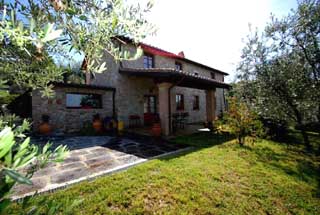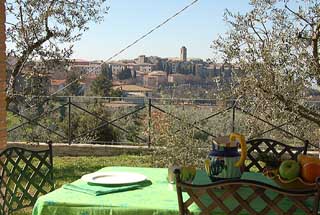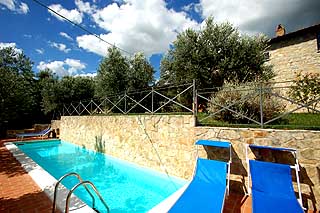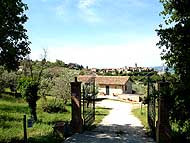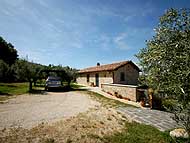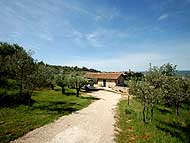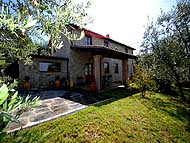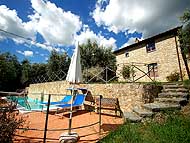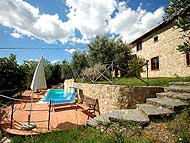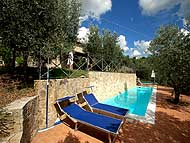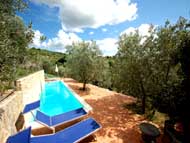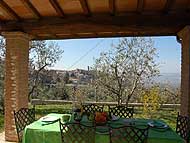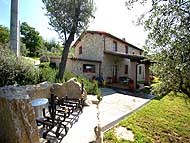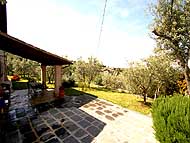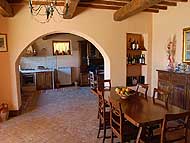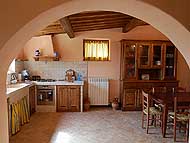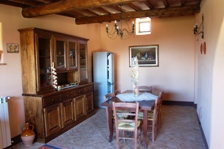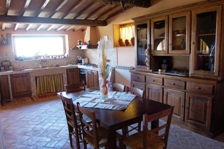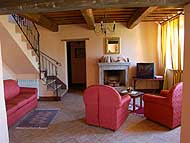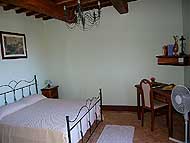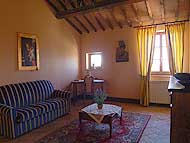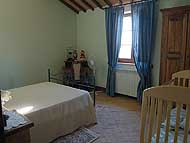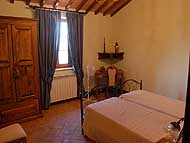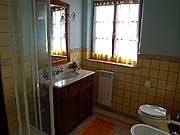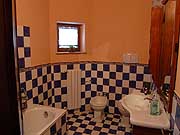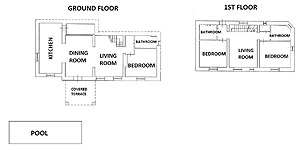|
SOUTHERN/CENTRE UMBRIA
In Umbria, a region that has gained a name for being the green heart of
Italy, tourism is growing because of the unfamiliar harmony between
nature, antiquities, historic centres and culture. The quiet of the
countryside, good provisions and an inimitable cuisine are the great
draw. This region is less touristy than Tuscany and this is
especially appreciated by many tourists.
Southern/centre Umbria
forms an ideal starting point for enjoying the peace of the surrounding
hilly and mountainous landscape and on the other hand making trips to
beautifull towns like Todi, Orvieto, Narni, Spoleto, Perugia, Gubbio,
Assisi. There are also numerous charming little villages – many of
medieval origin - as Amelia, Labro, Spello, Norcia, Bevagna, Montefalco
to visit.
In many towns and villages you can taste local dishes or buy
local wines and olive oil (generally of excellent quality). You
can also easily visit – in day trips - famous towns and charming
villages in the southern part of Tuscany such as Siena, Arezzo,
San Giminiano, Pienza, Cortona, Sinalunga, etc. Many tourists
visit also Rome from here (without staying in the city which is
very hot in summer) once or more times. It is possible to go by
car (journey of 1h-1h30) or by train from the stations of:
Terni, Narni-Amelia, Orte & Orvieto.
We
must not forget the mountains with some splendid woods, e.g. Terminillo
(up to 2000 metres by car). In around 1 hour it is possible to reach the
shimmering lakes of Bracciano, Vico, Piediluco, Bolsena and Trasimeno.
The Mediterranean Sea (mostly sand beaches) situated between Tarquinia
and Chiarone are 90-120 Kms away (around 1h20-1h40 driving). Near the
city of Terni you can also visit the Marmore falls (165 meters, one of
the highest of Europe), there is nearby also a
rafting/canoeing/hydrospeed center.
|
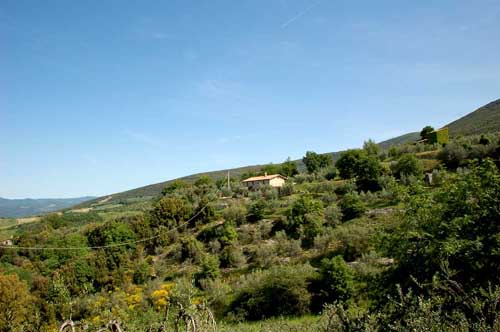 |
|
SURROUNDINGS
Lago di Bolsena (35 kms) is Italy's largest lake formed in the
crater of an extinct volcano. The water of Bolsena is so clear,
in fact, that it is completely safe to drink it. The local
government has gone to great efforts to maintain the lake's
natural purity; a technologically advanced purification system
has eliminated the errors that might have been made before
pollution-awareness was so developed. Luckily no industrial
development mars Bolsena's shores, nor its views, and the gently
sloping nature of the encircling land limits the amount of
spill-off and soil erosion which could effect the water's
transparency. The native fisherman still use the lake's water to
make the local culinary specialty - a fish soup called sbrosia -
a rarity to find.The lake is 12 km. long and 14 km. wide, with a
maximum depth of 151 meters. The most important town on the lake
is called Bolsena. Like so much of Italy, it bears the signs of
almost every important period of the Italian peninsula, going
back as far as the Iron Age and progressing through the times of
the martyrs, catacombs and miracles and on to the Middle Ages.
The Rocca Monaldeschi della Cervara sits at the top of the hill,
overlooking the medieval quarter of town. The castle was built
between the 12th and 14th centuries. It has been completely
renovated and since 1991 has housed the Museo Territoriale del
Lago di Bolsena (Lake Bolsena Territorial Museum). The museum is
well laid out; each of its three floors is dedicated to various
aspects of Bolsena's history, ranging from its prehistoric
volcanic origins to its Etruscan-Roman period. A walk along the
ramparts of the castle offers a gorgeous view of the entire lake
and should not be missed. The Church of St. Christine is the
town's other major site. It is a Romanesque church built in 1078
in a typical basilica style over the catacombs where St.
Christine, a young woman martyred during the reign of the Roman
Emperor Diocletian, was buried. From April to September,
excursion boats depart Bolsena town headed for Bisentina and
Martana, the islands in the lake. Both are privately owned and
Martana is not open to the public, but Bisentina is an ex-summer
residence of the Popes and has a large church on it. There are
also seven small chapels built around the island. Don't think
that Bolsena is just for history and culture buffs. It is also
ideal for swimming, sailing, relaxation and dining. One of my
fondest memories is having a delicious meal of grilled coregone
(a local fish from the lake) at one of the many unpretentious
restaurants lined up along the shore. If you happen to find one
that's serving sbrosia, consider it your lucky day.
Orvieto (20 kms) is a place of great historical importance. So
you see tourists the whole year round. Lots of them only visit
the well known cathedral, the cathedral square and the central
street full of ceramics and souvenir shops. They are wrong,
because there is a lot more to see in this city and even more in
the surrounding area. You have to go right through Orvieto to
get a real impression of the unfamiliar setting of the city and
the gleaming city walls on the volcanic tuff stone hill, plus
characteristic monuments and museums with Etruscan finds. |
|
